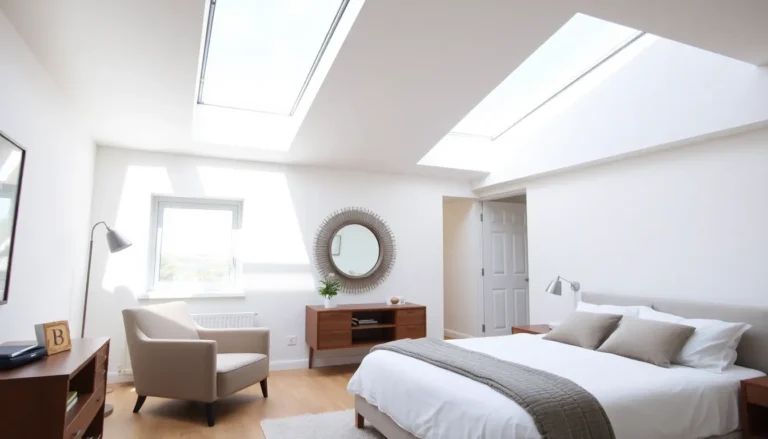When it comes to home improvement, every contractor knows that a solid insurance policy is as essential as a good toolbox. After all, nobody wants to be the star of a DIY disaster story. But how much should a contractor expect to shell out for that peace of mind? Understanding the cost of contractor insurance can feel like navigating a maze blindfolded—frustrating and slightly terrifying.
Table of Contents
ToggleUnderstanding Home Improvement Contractor Insurance
Home improvement contractor insurance provides critical protection for those in the contracting business. This type of insurance helps cover a range of risks that contractors face daily.
What Is Home Improvement Contractor Insurance?
Home improvement contractor insurance encompasses various policies designed to safeguard contractors from financial losses. General liability insurance protects against claims of property damage or bodily injury. Workers’ compensation insurance aids employees injured on the job, covering medical expenses and lost wages. Additionally, professional liability insurance protects against negligence claims linked to professional services. Each policy serves as a tool to manage specific risks in the contracting field.
Importance of Insurance for Contractors
Insurance plays a pivotal role in a contractor’s success. It helps manage unexpected expenses arising from accidents or claims. Legal challenges can emerge without insurance, potentially leading to significant financial burdens. Obtaining insurance also builds credibility with clients, as many homeowners prefer contractors with proper coverage. Moreover, securing a job often requires proof of insurance, making it a necessity for competitive contracts.
Factors Influencing Insurance Costs
Several elements directly impact the costs associated with home improvement contractor insurance. Understanding these factors helps contractors make informed decisions.
Type of Coverage Required
Different types of coverage influence insurance costs significantly. General liability coverage typically costs less than professional liability insurance. Workers’ compensation requirements vary by state, affecting the overall premium. Specialized policies for risks like tool theft or equipment breakdown may also increase costs. Contractors must assess their specific coverage needs to determine the most suitable policy and associated costs.
Project Scope and Risk Assessment
The project’s scope directly influences insurance costs. Larger projects usually involve higher risks, leading to increased premiums. Complex renovations or new constructions require more comprehensive coverage, raising expenses. Contractors with a history of claims often face higher rates due to perceived risk. Conducting a thorough risk assessment before bidding on projects ensures that contractors select appropriate insurance, keeping costs manageable.
Geographic Location Impact
Geographic location plays a crucial role in determining insurance costs. Areas prone to natural disasters, like hurricanes or floods, typically lead to higher premiums. Local regulations and state laws also impact coverage requirements and costs. Urban areas with higher population densities may involve greater risk, resulting in increased insurance rates. Understanding regional factors allows contractors to better anticipate their insurance expenses.
Average Costs of Home Improvement Contractor Insurance
Understanding the average costs associated with home improvement contractor insurance involves analyzing several components. Knowing these components helps contractors budget effectively.
Breakdown of Insurance Premiums
Premium costs usually reflect several key factors. Business size often influences insurance expenses, as larger businesses generally face higher premiums due to increased risk. The nature of services offered also plays a crucial role. For instance, contractors specializing in high-risk projects incur higher premiums. Experience levels in the industry contribute as well; seasoned contractors with established track records often receive more favorable rates. Claims history should not be overlooked; a history of frequent claims typically results in elevated premiums. Lastly, policy deductibles affect costs significantly, with lower deductibles usually leading to higher premiums.
Comparison of Costs by Coverage Type
Different types of coverage present varying cost structures. General liability insurance generally costs between $400 and $1,000 annually, depending on factors like location and business size. Professional liability insurance, also known as errors and omissions insurance, tends to be higher, with prices ranging from $1,000 to $3,000 annually. Workers’ compensation insurance varies by state; typical costs range from $0.75 to $2.74 per $100 of payroll. Contractors focused on specialized trades may encounter premiums on the higher end. Additionally, bundling policies can lead to cost savings, benefiting contractors aiming to minimize expenses while maximizing coverage.
Tips for Reducing Insurance Costs
Reducing insurance costs is achievable through various strategies. By implementing effective risk management practices, contractors can lower their premiums significantly.
Improving Risk Management Practices
Enhancing risk management practices leads to fewer insurance claims. Conducting regular safety training for employees minimizes accidents on-site. Utilizing quality equipment reduces damage risks during projects. Evaluating project scopes thoroughly ensures accurate risk assessments. Maintaining a clean and organized workspace also decreases liability risks. These proactive measures demonstrate to insurers a commitment to safety, which can lower premiums over time.
Bundling Insurance Policies
Bundling different insurance policies offers considerable savings. Contractors can often negotiate a lower rate when purchasing multiple coverages from one provider. Combining general liability, professional liability, and workers’ compensation policies creates convenience alongside cost reduction. This approach simplifies managing insurance needs while ensuring ample coverage. Ensuring all policies align with specific business needs further enhances protection. Many insurers reward the consolidation of policies with discounts that can add up to significant savings.
Investing in home improvement contractor insurance is a crucial step for contractors seeking to protect their business and manage risks effectively. Understanding the various factors that influence insurance costs allows contractors to make informed choices tailored to their unique needs. By prioritizing risk management practices and considering bundling options, they can reduce expenses while ensuring comprehensive coverage.
Ultimately, having the right insurance not only safeguards against unexpected challenges but also enhances credibility with clients. This protection can be the difference between thriving in the competitive home improvement market and facing significant setbacks.





